Introduction
AI has evolved. Language models now reason, summarize, code, and teach with remarkable skill. But here's the problem: they work in isolation. Despite their impressive capabilities, these models remain disconnected from the real-time, dynamic ecosystem of digital tools, files, and services that power modern life.
Key Concept: Master this foundational idea. Everything that follows builds on it.
Enter the Model Context Protocol. Introduced by Anthropic in late 2024, MCP changes everything. It provides a standard, secure, and flexible bridge between language models and the external systems you depend on daily—databases, email, calendars, cloud storage, and far more.
Picture this: you ask your AI assistant to schedule a meeting, and it responds with "Please paste your calendar here." Frustrating, right? This common friction point reveals a deeper limitation in current AI systems. Now imagine a financial analyst drowning in spreadsheets who simply tells their AI assistant to generate reports and pull data—no tedious copy-pasting required. That's the transformation MCP enables, shifting from passive information sharing to active digital collaboration.
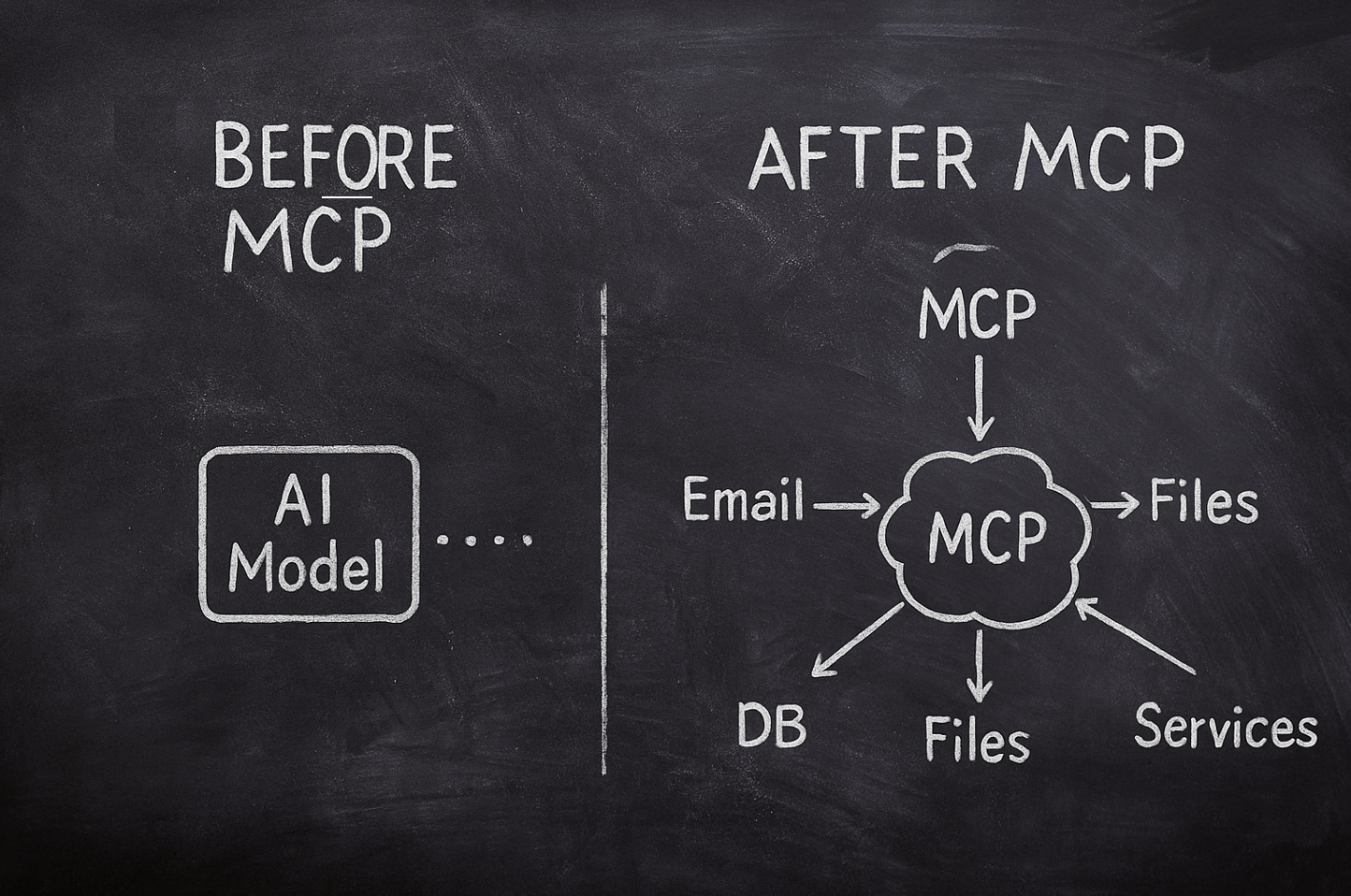
The Genesis of a Protocol
MCP was born from frustration. Users wanted their AI assistants to access files, query real-time data, perform simple actions—all without manual copying, reformatting, or endless explanations. These weren't design choices. They were architectural failures that treated AI as an isolated tool rather than an integrated partner in your digital workflow.
Before MCP? AI models interacted with the outside world through manually crafted APIs, one-off integrations, or fragile scripts that broke with every update. Each new connection demanded engineering effort, creating massive barriers between what AI could do and what it actually did. The result? A fragmented, frustrating landscape where AI's true potential died not from lack of intelligence, but from lack of access to the digital environment where real work happens.
MCP fixes this. It's more than a technical solution—it's a philosophical revolution that makes AI collaborate with your existing tools instead of trying to replace them.
Architectural Philosophy: Beyond Traditional APIs
MCP isn't just another API. It fundamentally reimagines how external capabilities are exposed to AI. Traditional APIs were built for developers—people who read documentation, interpret error codes, juggle authentication tokens, and manage state across multiple endpoints.
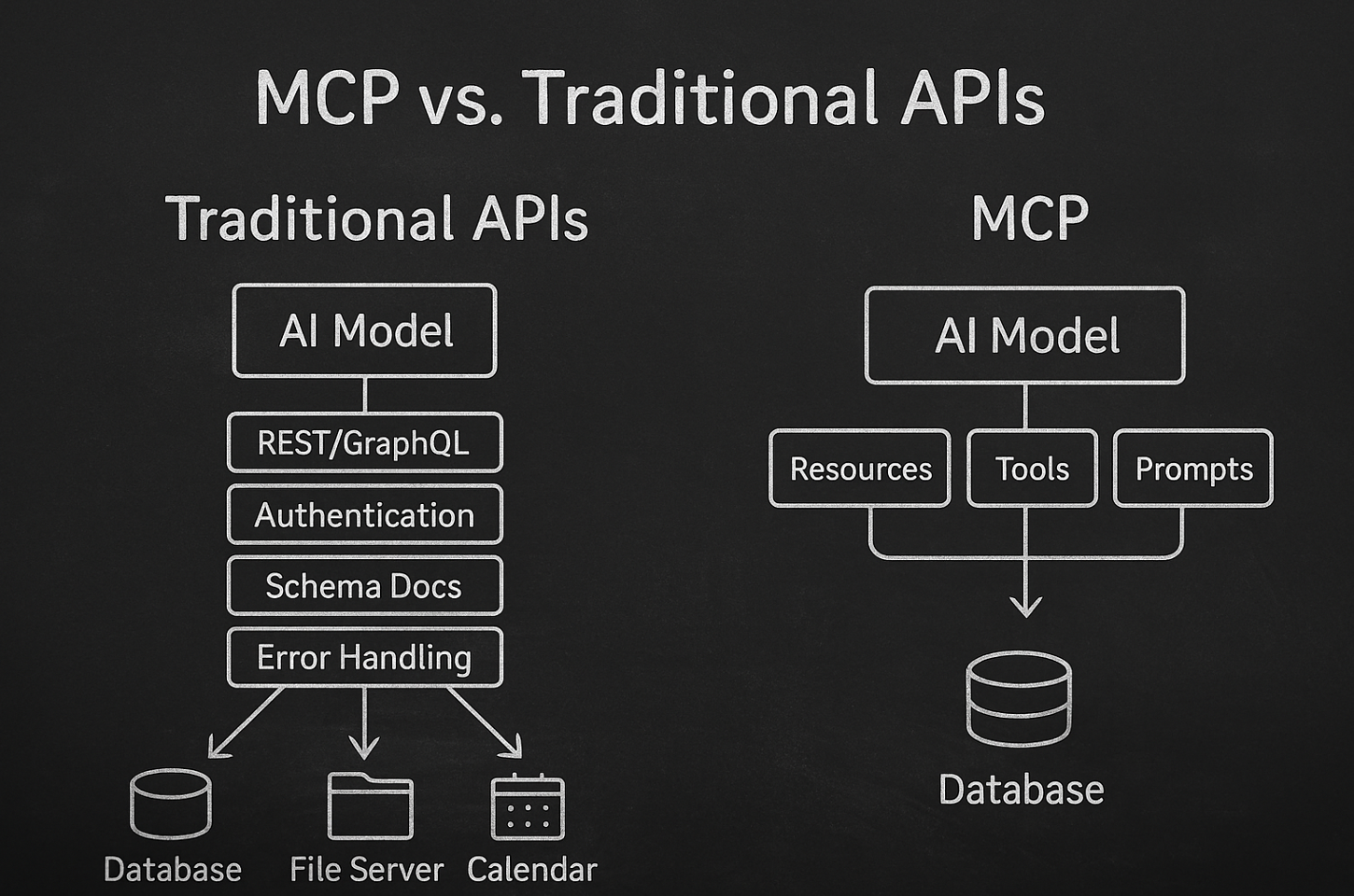
MCP flips that model completely. It's designed specifically for AI cognition, recognizing that language models perceive and interact with systems in fundamentally different ways than human developers do. Instead of exposing low-level endpoints that require technical expertise, MCP distills entire systems into three high-level primitives that match how LLMs naturally think:
- Resources – Information sources like files, databases, knowledge bases, and APIs
- Tools – Actions the AI can perform: send email, update spreadsheets, trigger workflows
- Prompts – Contextual suggestions, templates, and domain-specific guidance
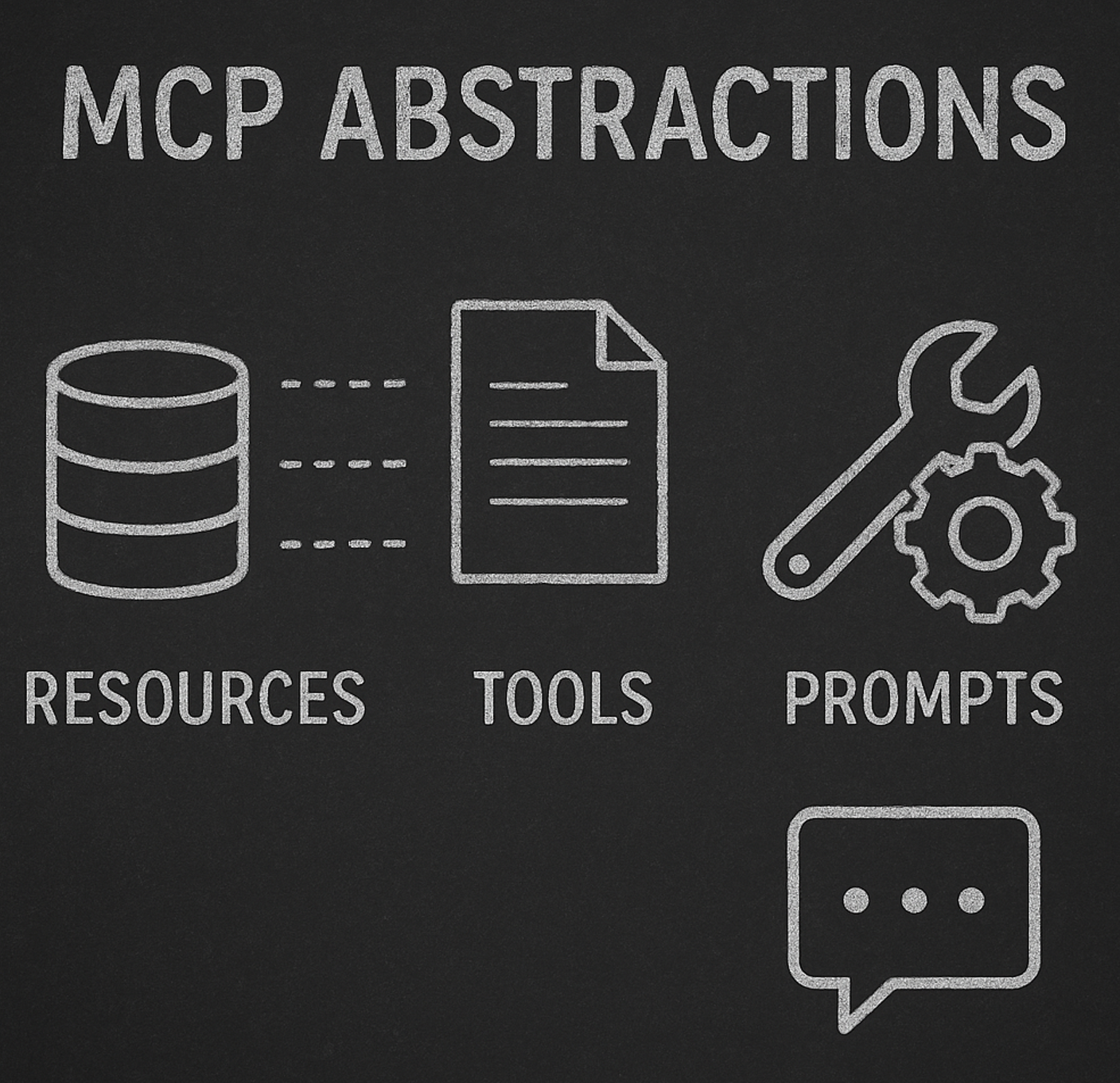
These primitives are described in a structured yet semantically rich format that LLMs understand and use naturally, without the rigid parameter passing and error handling that traditional APIs demand.
MCP Configuration Example
Want to see what a basic MCP server configuration looks like? Here you go:
{
"mcpServers": {
"filesystem": {
"command": "npx",
"args": ["-y", "@modelcontextprotocol/server-filesystem", "/path/to/allowed/files"],
"env": {
"MCP_FILESYSTEM_READONLY": "true"
}
},
"database": {
"command": "mcp-server-postgres",
"args": ["--connection-string", "postgresql://user:pass@localhost/db"],
"env": {
"MCP_DB_PERMISSIONS": "read-only"
}
},
"calendar": {
"command": "python",
"args": ["-m", "mcp_calendar_server"],
"env": {
"CALENDAR_API_KEY": "${GOOGLE_CALENDAR_API_KEY}",
"MCP_CALENDAR_SCOPE": "read-write"
}
}
}
}Enhanced Security: The Multi-Layered Defense
Giving AI access to external systems introduces serious risks. What if your AI sends an unintended message? Modifies sensitive data? Acts on misinterpreted instructions? The stakes skyrocket when AI can take real actions in your digital environment.

MCP tackles these challenges head-on with a sophisticated, multi-layered security architecture that shifts focus from output safety (what the model says) to action safety (what the model does):
1. Capability-Based Permissions
Forget traditional role-based access control. MCP uses capability-based security where AI can only perform actions you explicitly grant. Each tool and resource requires specific permissions:
# Example MCP tool with capability restrictions
@mcp_tool
async def send_email(to: str, subject: str, body: str):
"""Send an email - requires 'email:send' capability"""
# Capability check happens at the protocol level
if not has_capability("email:send"):
raise PermissionError("email:send capability required")
# Additional validation
if not validate_email_address(to):
raise ValueError("Invalid email address")
return await email_service.send(to, subject, body)2. Granular Scopes and Resource Isolation
Control access at multiple levels. Method, resource, field, or even specific data ranges—you choose. One tool can't access another's data without explicit permission:
{
"permissions": {
"calendar": {
"scope": "read-write",
"restrictions": {
"time_range": "next_30_days",
"calendar_ids": ["work", "meetings"],
"excluded_fields": ["attendee_emails"]
}
},
"filesystem": {
"scope": "read-only",
"allowed_paths": ["/documents/public", "/reports"],
"file_types": [".md", ".txt", ".pdf"]
}
}
}3. Human-in-the-Loop Approvals
For sensitive actions, MCP can pause execution and request your approval in real-time:
@mcp_tool
async def delete_file(file_path: str):
"""Delete a file - requires human approval for sensitive paths"""
if is_sensitive_path(file_path):
approval = await request_human_approval(
action="delete_file",
details=f"AI wants to delete: {file_path}",
risk_level="high"
)
if not approval.granted:
raise PermissionError(f"User denied deletion: {approval.reason}")
return filesystem.delete(file_path)4. Audit Trails and Monitoring
MCP logs every action with full context, creating an audit trail that enables both debugging and security monitoring:
# Automatic audit logging for all MCP actions
{
"timestamp": "2024-12-15T10:30:45Z",
"session_id": "sess_abc123",
"tool": "send_email",
"parameters": {
"to": "user@company.com",
"subject": "Weekly Report"
},
"result": "success",
"approval_required": false,
"execution_time": "1.2s",
"user_context": {
"intent": "Send weekly status report",
"conversation_id": "conv_xyz789"
}
}5. Sandboxing and Rate Limiting
MCP servers can implement additional safety measures to protect your systems:
class MCPSecurityLayer:
def __init__(self):
self.rate_limiter = RateLimiter(calls_per_minute=60)
self.sandbox = ActionSandbox()
async def execute_tool(self, tool_name: str, params: dict):
# Rate limiting
await self.rate_limiter.acquire()
# Sandbox sensitive operations
if tool_name in ["file_write", "database_update", "api_call"]:
return await self.sandbox.safe_execute(tool_name, params)
return await self.direct_execute(tool_name, params)Think of MCP's layered security as gated checkpoints at every bridge between your AI and digital assets—nothing crosses without proper authorization and monitoring.
Technical Implementation: Elegance in Simplicity
MCP is built on JSON-RPC 2.0. Clean. Minimal. Robust. This choice prioritizes interoperability, ease of implementation, and clarity over complex custom protocols. All messages follow predictable structures: requests include a method, parameters, and ID; responses return a result or error.
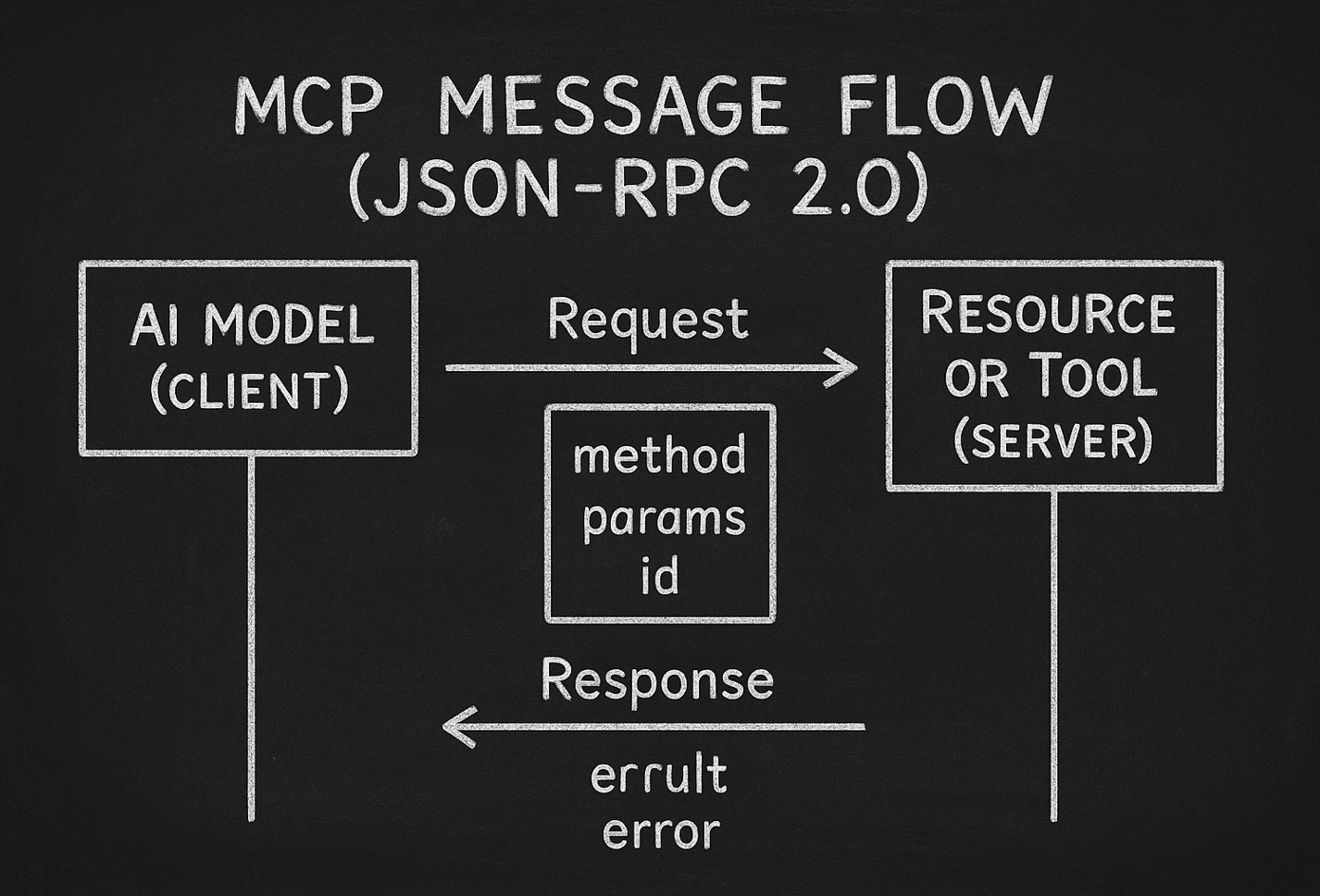
Basic MCP Message Flow
// Tool discovery request
{
"jsonrpc": "2.0",
"id": 1,
"method": "tools/list"
}
// Tool discovery response
{
"jsonrpc": "2.0",
"id": 1,
"result": {
"tools": [
{
"name": "send_email",
"description": "Send an email to specified recipients",
"inputSchema": {
"type": "object",
"properties": {
"to": {"type": "string"},
"subject": {"type": "string"},
"body": {"type": "string"}
},
"required": ["to", "subject", "body"]
}
}
]
}
}
// Tool execution request
{
"jsonrpc": "2.0",
"id": 2,
"method": "tools/call",
"params": {
"name": "send_email",
"arguments": {
"to": "team@company.com",
"subject": "Project Update",
"body": "The Q4 analysis is complete..."
}
}
}Standardized discovery and introspection mechanisms help models find available resources or tools, understand their usage patterns, and handle errors gracefully—all while supporting extensions for domain-specific enhancements without breaking compatibility.
Resource Access Example
# MCP Resource implementation
class DatabaseResource:
def __init__(self, connection_string: str):
self.db = connect(connection_string)
@mcp_resource("database://sales")
async def get_sales_data(self, date_range: str = "last_30_days"):
"""Access sales database with time-based filtering"""
query = self.build_query(date_range)
results = await self.db.execute(query)
return {
"uri": f"database://sales?range={date_range}",
"mimeType": "application/json",
"text": json.dumps(results, indent=2)
}
# Usage by AI
resource_data = await mcp_client.read_resource("database://sales?range=last_7_days")
# AI can now reason about the sales data in contextReal-World Impact: Transforming AI Utility
The difference between pre-MCP and post-MCP AI assistance? Dramatic. Night and day. Let's look at a financial analyst's workflow:
Before MCP: "I need to analyze last quarter's performance."
- Manually export data from multiple systems
- Copy-paste into AI chat
- Ask for analysis of static data
- Manually implement recommendations
- Repeat for each data source
After MCP: "Analyze last quarter's performance and prepare a board presentation."
- AI directly accesses financial databases, CRM, and market data
- Performs analysis with live, current data
- Generates comprehensive report with charts
- Updates presentation template
- Schedules review meeting and sends preview to stakeholders
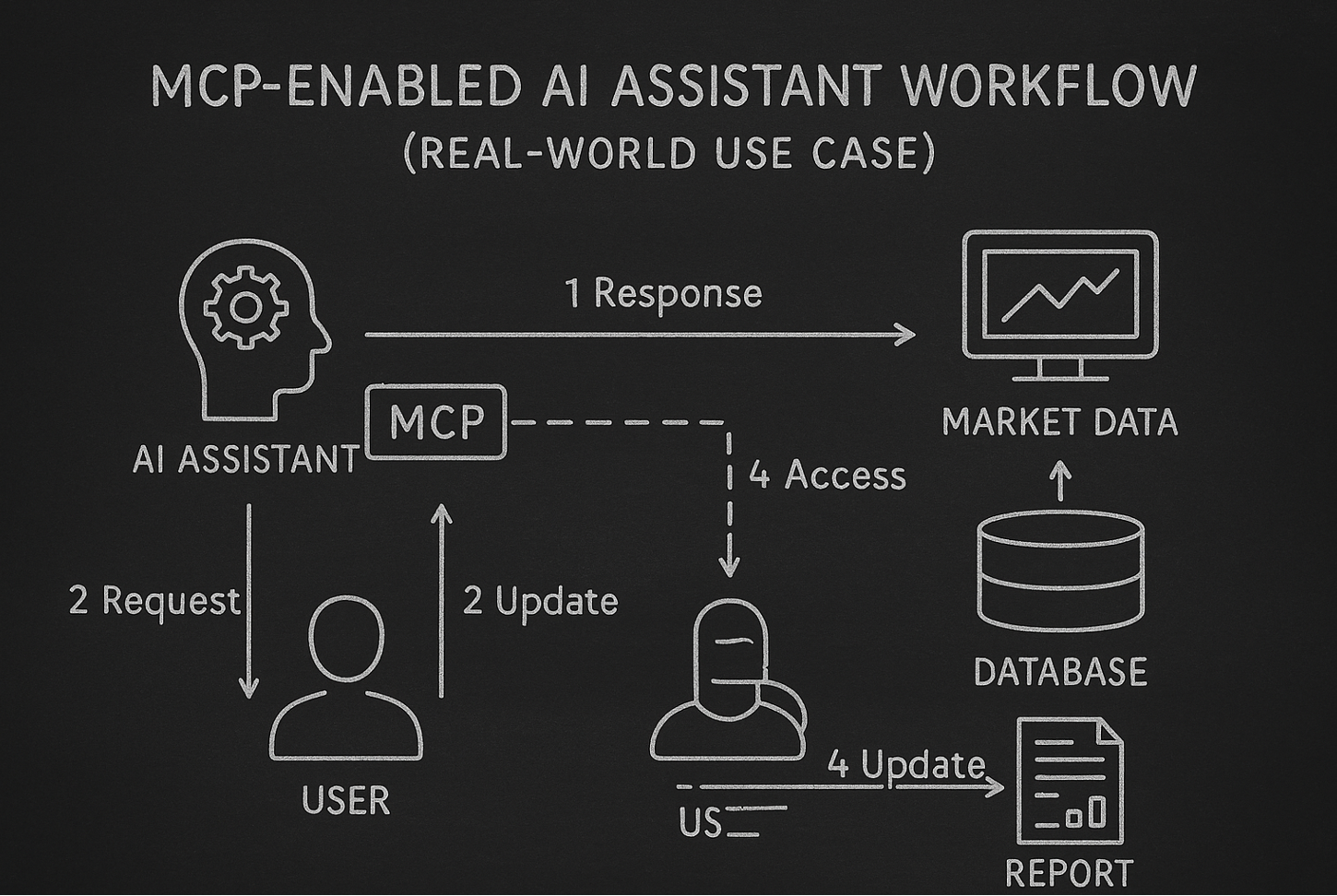
This transformation is happening now across software development, sales operations, customer support, and content creation. MCP transforms passive chatbots into proactive, context-aware assistants that orchestrate complex workflows across your entire digital ecosystem.
Example: Development Workflow Integration
# MCP-enabled development assistant
@mcp_tool
async def analyze_codebase(repo_path: str, focus_area: str):
"""Analyze codebase for issues and improvements"""
# Access code resources
code_files = await mcp_client.read_resource(f"filesystem://{repo_path}")
git_history = await mcp_client.call_tool("git_log", {"path": repo_path, "limit": 50})
# Perform analysis
analysis = await analyze_code_quality(code_files, git_history, focus_area)
# Take actions based on findings
if analysis.has_security_issues:
await mcp_client.call_tool("create_github_issue", {
"title": "Security vulnerabilities found",
"body": analysis.security_report,
"labels": ["security", "urgent"]
})
# Update documentation
await mcp_client.call_tool("update_readme", {
"section": "code_quality",
"content": analysis.quality_summary
})
return analysisIndustry Adoption and Ecosystem Growth
MCP adoption follows a predictable but accelerating curve. It started with developer-friendly applications and now expands into enterprise use cases:
- Developer tools – IDEs, editors, code repositories, CI/CD pipelines
- Productivity applications – Calendar systems, task management, note-taking, document editing
- Enterprise pilots – CRM systems, knowledge bases, business intelligence tools, workflow automation
- Cross-domain standards – Common schemas, shared vocabularies, industry-specific extensions
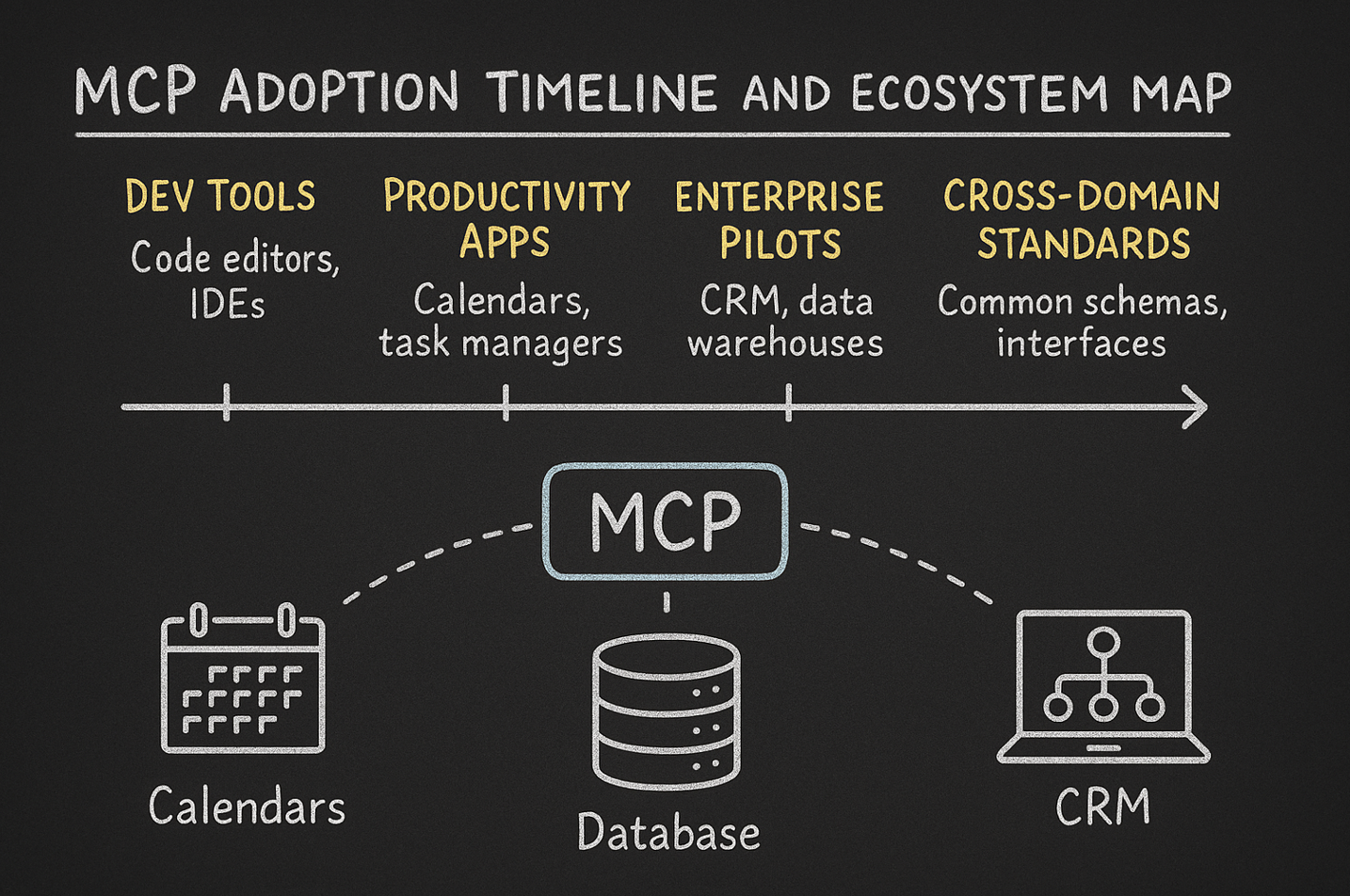
Official libraries exist for Python, TypeScript, and other popular languages, with a growing open-source community extending MCP support across languages and domains—the protocol's simplicity enables rapid adoption, while its extensibility ensures it evolves with emerging use cases.
Building Your First MCP Server
Ready to build? Here's a minimal but functional MCP server:
from mcp import FastMCPServer
import asyncio
app = FastMCPServer("my-tools")
@app.tool()
async def calculate_roi(investment: float, returns: float, time_period: int):
"""Calculate return on investment over a time period"""
roi_percentage = ((returns - investment) / investment) * 100
annual_roi = roi_percentage / time_period
return {
"total_roi": round(roi_percentage, 2),
"annual_roi": round(annual_roi, 2),
"profit": round(returns - investment, 2)
}
@app.resource("finances://budget")
async def get_budget_data():
"""Access current budget information"""
# In real implementation, this would query your financial system
return {
"uri": "finances://budget/current",
"mimeType": "application/json",
"text": json.dumps({
"monthly_budget": 10000,
"spent_this_month": 7500,
"remaining": 2500
})
}
if __name__ == "__main__":
asyncio.run(app.run())Challenges and Limitations
Important Consideration: This approach offers significant benefits, but you must understand its limitations and potential challenges.
No protocol is perfect. MCP faces several key challenges that you, as a developer or organization, need to understand:
Technical Challenges
Latency Considerations: JSON-RPC 2.0 is lightweight and efficient, but applications requiring sub-millisecond response times—think high-frequency trading or real-time gaming—may find the protocol overhead problematic. The request-response pattern doesn't naturally support streaming or real-time updates either.
Standardization Gaps: Not all systems map cleanly to MCP's three-primitive model. Legacy systems, complex state machines, or highly specialized APIs demand significant adaptation. Domain-specific schema efforts are still maturing, leading to inconsistent implementations across similar tools.
Security and Operational Challenges
Implementation Burden: Building truly secure MCP servers requires careful design around permission models, input validation, and error handling—many early implementations lack robust security controls, creating potential vulnerabilities.
Debugging Complexity: When AI agents orchestrate multi-step workflows across multiple MCP servers, diagnosing failures becomes challenging. Traditional debugging tools weren't designed for AI-driven execution flows.
Permission Model Complexity: As systems grow, managing granular permissions across dozens of tools and resources becomes unwieldy without sophisticated tooling.
These challenges are solvable through better tooling, clearer documentation, and continued protocol evolution. But they represent real considerations for production deployments.
Future Directions and Evolution
The MCP ecosystem is evolving rapidly. Several exciting developments loom on the horizon:
Next-Generation Security
- Time-bounded permissions: Temporary access grants that automatically expire
- Intent-based authorization: Permissions based on high-level goals rather than specific actions
- AI-powered threat detection: Systems that learn to identify suspicious patterns in AI behavior
Performance and Scalability
- Intelligent caching: Protocol-level caching that understands AI usage patterns
- Batch operations: Efficient handling of multiple related actions
- Streaming support: Real-time data feeds and progressive responses
Ecosystem Maturity
- Schema registries: Centralized, versioned schemas for common business domains
- Cross-platform standards: Unified approaches to calendar, email, file systems, and databases
- Marketplace ecosystems: Curated collections of verified, secure MCP servers
Integration with Autonomous Systems
As AI systems evolve from reactive assistants to proactive agents, MCP becomes the infrastructure that enables them to operate safely and effectively across complex tool landscapes, with future versions potentially including:
- Workflow orchestration: Native support for multi-step, conditional operations
- Agent collaboration: Protocols for multiple AI agents to coordinate through shared MCP resources
- Learning and adaptation: Systems that improve their tool usage based on outcomes and feedback
Conclusion: A Foundation for Integration
Best Practice: Follow these recommended practices to achieve optimal results and avoid common pitfalls.
MCP is more than a protocol. It's a philosophy that understands AI must be integrated into your digital environment—not work in isolation from it. By standardizing how language models access and utilize external resources, MCP enables a new generation of AI assistants that aren't just conversational but genuinely useful in real-world workflows.
The protocol's success hinges on careful adoption, ongoing development, and a community dedicated to both innovation and safety. Early implementations should prioritize clear permission boundaries, thorough logging, and gradual expansion of capabilities as confidence grows.
MCP lays the groundwork for a future where AI doesn't just discuss your world—it works within it, seamlessly integrating into every tool, system, and workflow that matters to you, and as the protocol advances and adoption increases, the gap between AI's potential and its practical usefulness continues to shrink.
The future isn't just AI that helps you. It's AI that works with you—embedded in every click, task, and interaction that makes up your digital life. MCP makes that future not only possible but practical and secure.